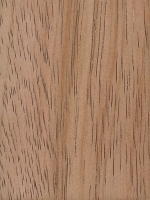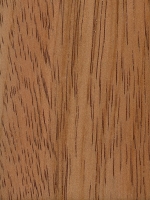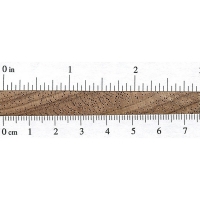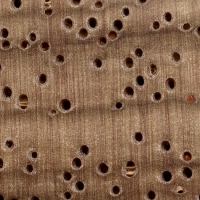 |
Common Name(s): Tornillo Scientific Name: Cedrelinga catenaeformis Distribution: Tropical South America Tree Size: 65-115 ft (20-35 m) tall, 3-6 ft (1-1.9 m) trunk diameter Average Dried Weight: 35 lbs/ft3 (555 kg/m3) Specific Gravity (Basic, 12% MC): .47, .55 Janka Hardness: 950 lbf (4,230 N) Modulus of Rupture: 9,870 lbf/in2 (68.1 MPa) Elastic Modulus: 1,574,000 lbf/in2 (10.86 GPa) Crushing Strength: 5,950 lbf/in2 (41.1 MPa) Shrinkage: Radial: 3.8%, Tangential: 6.9%, Volumetric: 12.6%, T/R Ratio: 1.8 |
Color/Appearance: Heartwood is light to golden brown. Very large, open pores also give a pronounced veined look to facegrain surfaces. Sapwood isn’t often seen, and the paler color gradually transitions into the darker heartwood.
Grain/Texture: Grain is straight to slightly interlocked. Coarse, uniform texture with moderate natural luster.
Endgrain: Diffuse-porous; solitary and radial multiples; very large pores in no specific arrangement, very few; reddish brown mineral/gum deposits common; parenchyma vasicentric; narrow rays, spacing normal to fairly close.
Rot Resistance: Rated as moderately durable; poor insect resistance.
Workability: Easy to work with hand or machine tools, yet due to it’s low density and interlocked grain, fuzzy surfaces may result from some machining operations. Extra sanding or very sharp tools may be necessary to obtain a smooth finish. Turns, glues, and finishes well.
Odor: No characteristic odor (though green lumber can have an unpleasant scent).
Allergies/Toxicity: Besides the standard health risks associated with any type of wood dust, no further health reactions have been associated with Tornillo. See the articles Wood Allergies and Toxicity and Wood Dust Safety for more information.
Pricing/Availability: Despite the tree’s large size, Tornillo is only occasionally available as lumber, and is more commonly seen as smaller craft or turning blanks. Prices are moderate for an imported hardwood.
Sustainability: This wood species is not listed in the CITES Appendices or on the IUCN Red List of Threatened Species.
Common Uses: Furniture, turned objects, construction/utility wood, and paper (pulpwood).
Comments: Tornillo has some of the largest pores of any commercial wood in the world. Anything above 200 micrometers is considered very large, yet Tornillo’s vessel diameters are routinely over 300 or 400 micrometers, upwards to approximately 500µm! These large pores give it a unique open texture, with the pores appearing as thin dark veins on all facegrain surfaces.
None available.







